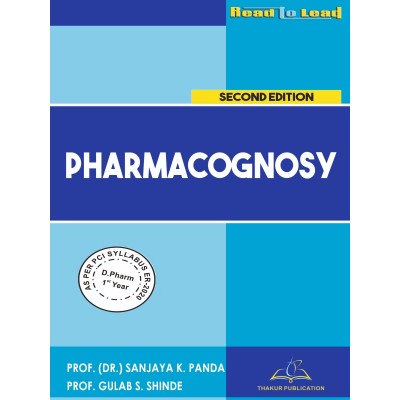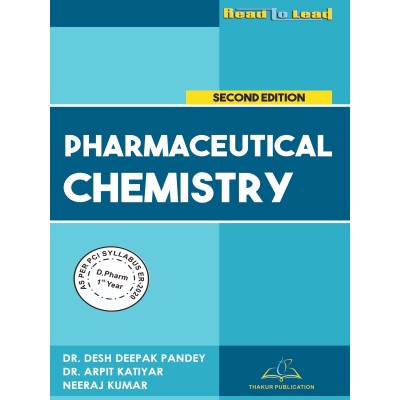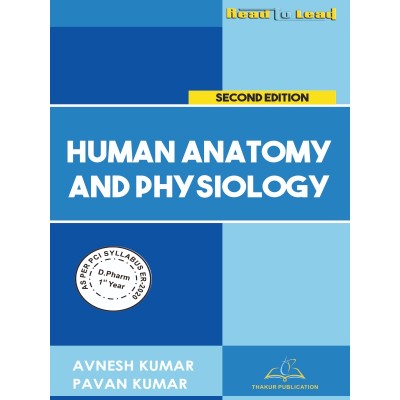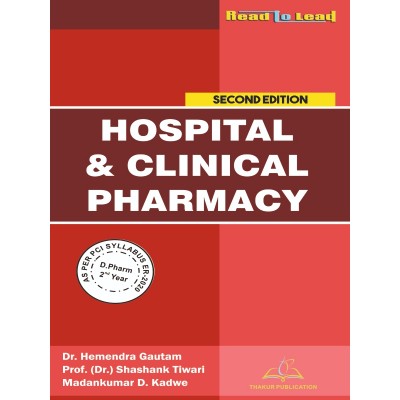D.Pharm Exit Examination Book (DPEE) KIT
₹550.00
₹495.00
Save 10%
Tax excluded
![]() Exit Exam Preparation Lectures
Exit Exam Preparation Lectures
Click below to Buy E-Book Edition:
The ‘D.Pharm Exit Exam Kit’ by Thakur Publication is an essential study resource for students preparing for their D.Pharm exit exams. This comprehensive kit includes a wide range of practice questions, solved papers, and exam-oriented content, designed to help students revise and test their knowledge effectively.
AS PER PCI SYLLABUS – 7000+ MCQs – COVERED ALL SUBJECTS
With its user-friendly format and reliable content, the D.Pharm Exit Exam Kit ensures students are well-equipped to excel in their exams and embark on a successful pharmaceutical career.
ISBN- 978-93-6180-537-0
Syllabus
The Syllabus for the DPEE shall comprise of subjects/knowledge areas as per the Diploma in Pharmacy Education Regulations 2020 (ER 2020) issued by Pharmacy Council of India. An extract of the same is as follows:
PHARMACEUTICS
History of the profession of pharmacy in India in relation to pharmacy education, industry, pharmacy practice and various professional associations, Pharmacopoeias, Packaging materials, Pharmaceutical aids, Preservatives, Unit operations - Size reduction, Size separation, Mixing, Filtration, Drying, Extraction, Tablets, Capsules, Liquid oral preparations, Topical preparations, Nasal preparations, Ear preparations, Powders and granules, Sterile formulations, Immunological products. Basic structure, layout, sections, and activities of pharmaceutical manufacturing plants, Quality control and quality assurance, current Good Manufacturing Practice (cGMP), Introduction to the concept of calibration and validation, Novel drug delivery systems
PHARMACY LAW AND ETHICS
General principles of law, history and various acts related to drugs and pharmacy profession: Pharmacy Act-1948 and Rules, Pharmacy Practice Regulations 2015, Drugs and Cosmetics Act 1940 and Rules 1945 and New Amendments, Import of drugs, Manufacture of drugs, Study of schedule C and C1, G, H, H1, K, P, M, N, and X. Sale of Drugs, Administration of the Act and Rules, Narcotic Drugs and Psychotropic Substances Act 1985 and Rules, Drugs and Magic Remedies (Objectionable Advertisements) Act 1954, Prevention of Cruelty to Animals Act-1960, Poisons Act-1919,
FSSAI (Food Safety and Standards Authority of India) Act and Rules, National Pharmaceutical Pricing Authority, Code of Pharmaceutical Ethics, Medical Termination of Pregnancy Act and Rules, Role of all the government pharma regulator bodies, Good Regulatory practices, Introduction to BCS system of classification, Basic concepts of Clinical Trials, ANDA, NDA, New Drug Development, New Drugs and Clinical Trials Rules, 2019. Brand v/s Generic, Trade name concept, Introduction to Patent Law and Intellectual Property Rights, Emergency Use Authorization, Blood bank, Clinical Establishment Act and Rules, Biomedical Waste Management Rules 2016, Bioethics, Introduction to the Consumer Protection Act, Introduction to the Disaster Management Act, Medical Devices.
COMMUNITY PHARMACY & MANAGEMENT
Community pharmacy practice, Prescription and prescription handling, Communication skills, Patient counselling, Patient counselling points for chronic diseases/disorders - Hypertension, Diabetes, Asthma, Tuberculosis, Chronic obstructive pulmonary disease, and AIDS, Patient Package Inserts (PPI), Medication Adherence, Health Screening Services in Community Pharmacy, Over The Counter (OTC) Medications, Self-medication and role of pharmacists in promoting the safe practices during self-medication, Community Pharmacy Management, Digital Health, mHealth and Online pharmacies.
HOSPITAL & CLINICAL PHARMACY
Hospital Pharmacy, Good Pharmacy Practice (GPP) in hospital, Hospital Pharmacy Standards (FIP Basel Statements, AHSP), Introduction to NAQS guidelines and NABH Accreditation and Role of Pharmacists, Different Committees in the Hospital, Supply Chain and Inventory Control, Drug distribution, Compounding in Hospitals, Radio Pharmaceuticals, Application of computers in Hospital Pharmacy Practice, Clinical Pharmacy, Pharmaceutical care, Clinical laboratory tests used in the evaluation of disease states, Poisoning, Pharmacovigilance, Medication errors
HUMAN ANATOMY AND PHYSIOLOGY
Scope of Anatomy and Physiology, Structure of Cell, Tissues of the human body, Osseous system, Haemopoietic system, Lymphatic system, Cardiovascular system, Respiratory system, Digestive system, Skeletal muscles, Nervous system, Sense organs, Urinary system, Endocrine system, Reproductive system
PHARMACOLOGY
General Pharmacology, Drugs acting on the Peripheral Nervous System, Drugs acting on the Eye, Drugs acting on the Central Nervous System, Drugs acting on the Cardiovascular System, Drugs acting on Blood and Blood Forming Organs, Bronchodilators, Expectorants, Anti-tussive agents, Mucolytic agents, Drugs acting on the Gastro Intestinal Tract, Drugs acting on the Kidney, Hormones and Hormone Antagonists, Autocoids, Chemotherapeutic Agents, Drugs belonging to following classes: Penicillins, Cephalosporins, Aminoglycosides, Fluoroquinolones, Macrolides, Tetracyclines, Sulphonamides, Antitubercular drugs, Anti-fungal drugs, Anti-viral drugs, Anti-amoebic agents, Anthelmintics, Anti-malarial agents, Anti-neoplastic agents, Biologicals
PHARMACOTHERAPEUTICS
Pharmacotherapeutics, Definition, etiopathogenesis, clinical manifestations, non-pharmacological and pharmacological management of the diseases associated with Cardiovascular System, Respiratory System, Endocrine System, Central Nervous System, Gastro Intestinal Disorders, Haematological disorders, Infectious diseases – Tuberculosis, Pneumonia, Urinary tract infections, Hepatitis, Gonorrhoea and Syphilis, Malaria, HIV and Opportunistic infections, Viral Infections (SARS, CoV2), Musculoskeletal disorders, Dermatology, Psychiatric Disorders, Ophthalmology, Anti-microbial resistance, Women’s health
NOTE: SOAP notes and patient counselling exercises for the given clinical cases as mentioned in pharmacotherapeutics practical (PCI education regulations 2020) to be considered for the said examination.
PHARMACEUTICAL CHEMISTRY
Introduction to Pharmaceutical chemistry, Sources and types of errors, Impurities in pharmaceuticals, Volumetric analysis, Gravimetric analysis, Inorganic Pharmaceuticals- Haematinics, Gastro-intestinal Agents, Topical agents, Dental products, Medicinal gases, Heterocyclic compounds containing up to Three rings
Study of the following category of medicinal compounds in details as mentioned in D. Pharm. Education Regulation 2020 (ER 2020): Drugs Acting on Central Nervous System – Anaesthetics, Sedatives and Hypnotics, Antipsychotics, Anticonvulsants, Anti-Depressants
Drugs Acting on Autonomic Nervous System - Sympathomimetic Agents – Direct Acting, Indirect Acting Agents. Sympathomimetic Agents with Mixed Mechanism: Adrenergic Antagonists, Cholinergic Drugs and Related Agents, Cholinesterase Inhibitors, Cholinergic Blocking Agents, Synthetic Cholinergic Blocking Agents.
Drugs Acting on Cardiovascular System - Anti-Arrhythmic Drugs, Anti- Hypertensive Agents, Antianginal Agents, Diuretics
Hypoglycemic Agents, Analgesic and Anti-Inflammatory Agents, Anti-Infective Agents, Antifungal Agents, Urinary Tract Anti-Infective Agents, Anti-Tubercular Agents, Antiviral Agents, Antimalarials, Sulfonamides, Antibiotics, Anti-Neoplastic Agents
BIOCHEMISTRY AND CLINICAL PATHOLOGY
Introduction to biochemistry: Scope of biochemistry in pharmacy; Cell and its biochemical organization, Carbohydrates, Proteins, Lipids, Nucleic acids, Enzymes, Vitamins, Metabolism, Metabolism of Carbohydrates, Metabolism of Lipids, Metabolism of Amino acids (Proteins), Biological oxidation, Minerals, Water and Electrolytes, Introduction to Biotechnology, Organ function tests, Introduction to Pathology of Blood and Urine
PHARMACOGNOSY
Introduction to Pharmacognosy, Classification of drugs, Quality control of crude drugs, Occurrence, Distribution, Isolation, Identification tests, therapeutic activity and pharmaceutical applications of Alkaloids, Terpenoids, Glycosides, Volatile oils, Tannins and Resins. Biological source, chemical constituents, and therapeutic efficacy of the crude drugs covered in the syllabus mentioned in D. Pharm. ER2020. Plant fibres used as surgical dressings, Basic principles involved in the traditional systems of medicine like: Ayurveda, Siddha, Unani and Homeopathy, Method of preparation of Ayurvedic formulations like Arista, Asava, Gutika, Taila, Churna, Lehya and Bhasma, Role of medicinal and aromatic plants in national economy and their export potential, Herbs as health food, Herbal formulations, Herbal cosmetics, Phytochemical investigation of drugs.
SOCIAL PHARMACY
Introduction to Social Pharmacy, Concept of Health, National Health Policy, Introduction to Millennium Development Goals, Sustainable Development Goals, FIP Development Goals, Preventive healthcare, Nutrition and Health, Introduction to Microbiology and common microorganisms- Epidemiology, Causative agents, clinical presentations and Role of Pharmacists in educating the public in prevention of the class of diseases include: Respiratory infections, Intestinal infections, Arthropod, Surface infections, STDs, HIV/AIDS, Health systems and all ongoing National Health programs in India, Pharmacoeconomics
DPEE (SCREENING TEST) BLUE PRINT
|
PAPER-1 |
||
|
S.NO |
SUBJECT |
DISTRIBUTION OF MARKS |
|
1 |
Pharmaceutics |
40 |
|
2 |
Pharmacy Law and Ethics |
35 |
|
3 |
Community Pharmacy and Management |
40 |
|
4 |
Hospital and Clinical Pharmacy |
35 |
|
|
Total |
150 |
|
PAPER - 2 |
||
|
S.NO |
SUBJECT |
DISTRIBUTION OF MARKS |
|
1 |
Human Anatomy and Physiology |
50 |
|
2 |
Pharmacology |
50 |
|
3 |
Pharmacotherapeutics |
50 |
|
|
Total |
150 |
|
PAPER - 3 |
||
|
S.NO |
SUBJECT |
DISTRIBUTION OF MARKS |
|
1 |
Pharmaceutical Chemistry |
40 |
|
2 |
Biochemistry and Clinical Pathology |
40 |
|
3 |
Pharmacognosy |
35 |
|
4 |
Social Pharmacy |
35 |
|
|
Total |
150 |
D.Pharm2024/Exam (DPEE) KIT
32 Items
New
8 other products in the same category:
Comments (0)
No customer reviews for the moment.










 Exit Exam Preparation Lectures
Exit Exam Preparation Lectures












